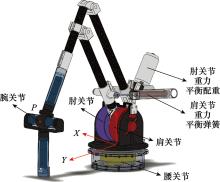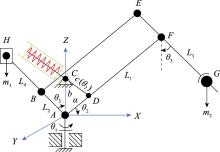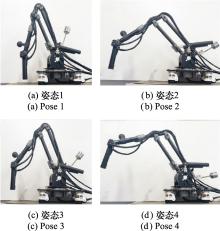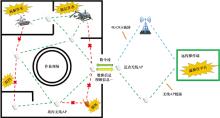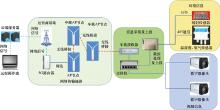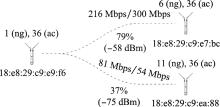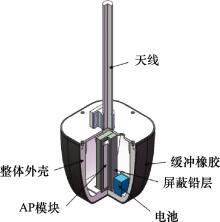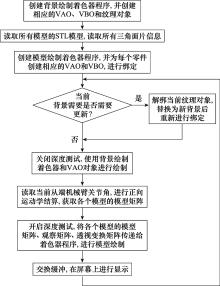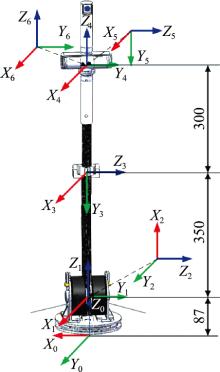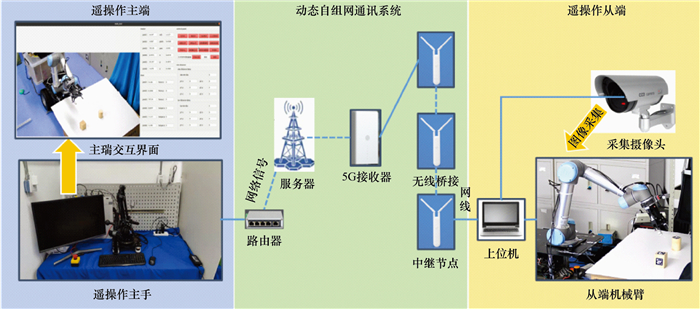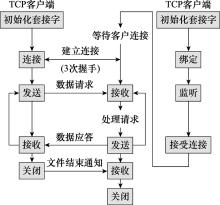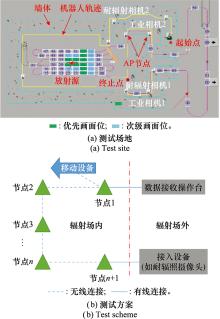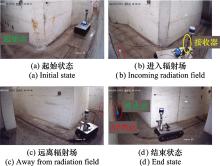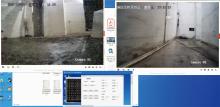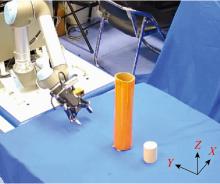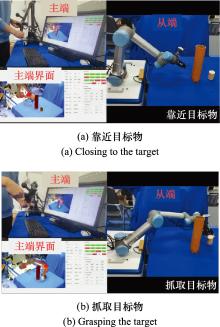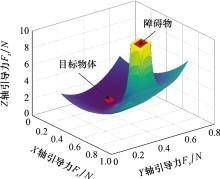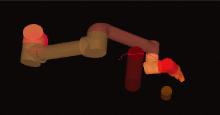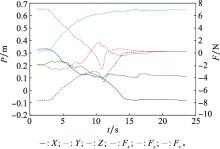Systems Engineering and Electronics ›› 2024, Vol. 46 ›› Issue (5): 1607-1618.doi: 10.12305/j.issn.1001-506X.2024.05.15
• Systems Engineering • Previous Articles
Design and experimental study of teleoperation system for emergency response in nuclear accident
Hang LI, Yanpeng HOU, Wusheng CHOU, Lingda MENG
- School of Mechanical Engineering & Automation, Beihang University, Beijing 100191, China
-
Received:2022-12-07Online:2024-04-30Published:2024-04-30 -
Contact:Hang LI
CLC Number:
Cite this article
Hang LI, Yanpeng HOU, Wusheng CHOU, Lingda MENG. Design and experimental study of teleoperation system for emergency response in nuclear accident[J]. Systems Engineering and Electronics, 2024, 46(5): 1607-1618.
share this article
Table 3
Communication rate of AP under different conditions"
| 距离 | 数据类型 | 局域网 | 5G | |||||||
| 数据1 | 数据2 | 数据3 | 平均值 | 数据1 | 数据2 | 数据3 | 平均值 | |||
| 0 m无AP | 上传/Mbps | - | - | - | - | 6.39 | 6.50 | 7.72 | 6.87 | |
| 下载/Mbps | - | - | - | - | 65.41 | 67.37 | 56.78 | 63.19 | ||
| 时延/ms | - | - | - | - | 28.00 | 40.00 | 20.00 | 29.33 | ||
| 0 m双AP | 上传/Mbps | 174.00 | 171.00 | 172.00 | 172.33 | 7.97 | 8.70 | 8.12 | 8.26 | |
| 下载/Mbps | 174.00 | 171.00 | 172.00 | 172.33 | 60.07 | 55.96 | 63.30 | 59.78 | ||
| 时延/ms | 1.00 | 1.00 | 1.00 | 1.00 | 29.00 | 23.00 | 24.00 | 25.33 | ||
| 65 m双AP | 上传/Mbps | 97.70 | 103.00 | 99.90 | 100.20 | 8.02 | 7.85 | 7.93 | 7.93 | |
| 下载/Mbps | 97.70 | 103.00 | 99.90 | 100.20 | 55.43 | 57.81 | 56.43 | 56.56 | ||
| 时延/ms | 2.00 | 3.00 | 2.00 | 2.33 | 28.00 | 24.00 | 26.00 | 26.00 | ||
| 130 m 3AP 自由组网 | 上传/Mbps | 55.80 | 56.40 | 56.50 | 56.23 | 7.47 | 8.03 | 7.33 | 7.61 | |
| 下载/Mbps | 55.80 | 56.40 | 56.50 | 56.23 | 55.76 | 51.83 | 54.55 | 54.05 | ||
| 时延/ms | 3.00 | 3.00 | 2.00 | 2.67 | 24.00 | 29.00 | 24.00 | 25.67 | ||
| 130 m 3AP 链式组网 | 上传/Mbps | 43.20 | 45.30 | 43.10 | 43.87 | 7.29 | 8.41 | 7.65 | 7.78 | |
| 下载/Mbps | 43.20 | 45.30 | 43.10 | 43.87 | 53.75 | 53.22 | 52.45 | 53.14 | ||
| 时延/ms | 3.00 | 3.00 | 2.00 | 2.67 | 29.00 | 26.00 | 71.00 | 42.00 | ||
Table 4
Communication delay of ad-hoc network"
| 次数 | 时延/ms | 次数 | 时延/ms | 次数 | 时延/ms | 次数 | 时延/ms | |||
| 1 | 7.38 | 9 | 9.57 | 17 | 4.77 | 25 | 7.65 | |||
| 2 | 1.94 | 10 | 1.82 | 18 | 1.75 | 26 | 1.42 | |||
| 3 | 2.29 | 11 | 1.80 | 19 | 3.64 | 27 | 6.35 | |||
| 4 | 1.75 | 12 | 1.94 | 20 | 8.65 | 28 | 13.88 | |||
| 5 | 3.57 | 13 | 1.86 | 21 | 10.44 | 29 | 5.78 | |||
| 6 | 10.9 | 14 | 1.84 | 22 | 7.65 | 30 | 4.21 | |||
| 7 | 6.20 | 15 | 4.50 | 23 | 4.69 | 31 | 2.97 | |||
| 8 | 3.46 | 16 | 4.70 | 24 | 6.99 | 32 | 2.94 |
| 1 | CUI J, TOSUNOGLU S, ROBERTS R, et al. A review of teleoperation system control[C]//Proc. of the Florida Conference Recent Advances in Robotics, 2003. |
| 2 |
BOGUE R . Robots in the nuclear industry: a review of technologies and applications[J]. Industrial Robot, 2011, 38 (2): 113- 118.
doi: 10.1108/01439911111106327 |
| 3 | 陈涛. 遥操作排爆机器人研制及其运动控制研究[D]. 济南: 山东大学, 2019. |
| CHEN T. Development and motion control research of teleoperation explosive ordnance disposal robot[D]. Jinan: Shandong University, 2019. | |
| 4 |
AKAHANE K , YONAI S , FUKUDA S , et al. The Fukushima nuclear power plant accident and exposures in the environment[J]. Environmentalist, 2012, 32 (2): 136- 143.
doi: 10.1007/s10669-011-9381-2 |
| 5 | GEORTZ R C , THOMPSON W M . Electronically controlled manipulator[J]. Nucleonics Ceased Publication, 1954, 12 (11): 46- 47. |
| 6 | TOKYO ELECTRIC POWER COMPANY. Decommissioning plan of Fukushima Daiichi nuclear power[EB/OL]. [2022-11-10]. http://www.tepco.co.jp/en/decommision/index-e.html, 2017. |
| 7 |
SHANG L , WANG H B , SI H Q , et al. Investigating the obstacle climbing ability of a coal mine search-and-rescue robot with a hydraulic mechanism[J]. Applied Sciences, 2022, 12 (20): 10485- 10489.
doi: 10.3390/app122010485 |
| 8 |
NAGATANI K , KIRIBAYASHI S , OKADA Y , et al. Emergency response to the nuclear accident at the Fukushima Daiichi nuclear power plants using mobile rescue robots[J]. Journal of Field Robotics, 2013, 30 (1): 44- 63.
doi: 10.1002/rob.21439 |
| 9 |
MAGNUSON S . Search-and-rescue robots needed, but market has yet to develop[J]. National Defense, 2011, 96 (10): 24- 26.
doi: 10.3969/j.issn.1002-4484.2011.10.011 |
| 10 | WU J W , ZHENG X M , CHEN J S , et al. Distributions and impacts of plutonium in the environment originating from the Fukushima Daiichi nuclear power plant accident: an overview of a decade of studies[J]. Journal of Environmental Radioactivity, 2022, 12 (6): 248- 253. |
| 11 |
KAWATSUMA S , MIMURA R , ASAMA H . Unitization for portability of emergency response surveillance robot system: experiences and lessons learned from the deployment of the JAEA-3 emergency response robot at the Fukushima Daiichi nuclear power plants[J]. Robomech Journal, 2017, 4, 6.
doi: 10.1186/s40648-017-0073-7 |
| 12 | DINH Q T , BUI N M T , NGUYEN T T , et al. Force reflecting joystick control for applications to bilateral teleoperation in construction machinery[J]. International Journal of Precision Engineering, 2017, 18 (3): 301- 315. |
| 13 |
SOYGUDER S , ABUT T . Haptic industrial robot control with variable time delayed bilateral teleoperation[J]. Industrial Robot, 2016, 43 (4): 390- 402.
doi: 10.1108/IR-12-2015-0213 |
| 14 |
TUGAL H , CARRASCO J . Teleoperation with nonlinear environments: multiplier approach[J]. IFAC-PapersOnLine, 2016, 49 (30): 308- 313.
doi: 10.1016/j.ifacol.2016.11.153 |
| 15 |
MATHESON A , DONMEZ B , REHMATULLAH F , et al. The effects of predictive displays on performance in driving tasks with multi-second latency aiding tele operation of lunar rovers[J]. Proceedings of the Human Factors and Ergonomics Society Annual Meeting, 2013, 57 (1): 21- 25.
doi: 10.1177/1541931213571007 |
| 16 | YASUYOSHI Y . The use of robots to respond to nuclear accidents: applying the lessons of the past to the Fukushima Daiichi nuclear power station[J]. Annual Review of Control, Robotics, & Autonomous Systems, 2021, 33 (4): 681- 710. |
| 17 | SATO N. Evaluation exercise in the seminar for standard test method of ground robot at fukushima robot test field[C]//Proc. of the IEEE International Conference on Intelligence and Safety for Robotics, 2021. |
| 18 | 刘青松, 张一心, 向文元, 等. 核电站机器人技术应用现状及发展趋势[J]. 机器人技术与应用, 2011, (3): 12- 16. |
| LIU Q S , ZHANG Y X , XIANG W Y , et al. Application status and development trend of robot technology in nuclear power plant[J]. Robot Technique and Application, 2011, (3): 12- 16. | |
| 19 | 杨汝清, 宋克威. "勇士号"遥控移动式作业机器人[J]. 高技术通讯, 1997, 7 (2): 4- 8. |
| YANG R Q , SONG K W . A "Warrior" teleoperation mobile robot[J]. High Technology Communications, 1997, 7 (2): 4- 8. | |
| 20 |
宋爱国. 力觉临场感遥操作机器人(1): 技术发展与现状[J]. 南京信息工程大学学报, 2013, 5 (1): 1- 19.
doi: 10.3969/j.issn.1674-7070.2013.01.001 |
|
SONG A G . Force teleoperation telerobot (1): review of the history and development[J]. Journal of Nanjing University of Information Science and Technology, 2013, 5 (1): 1- 19.
doi: 10.3969/j.issn.1674-7070.2013.01.001 |
|
| 21 | XIA Y, WAN Y, CHEN T. Investigation on bifurcation and chaos control for a spur pair gear system with and without nonlinear suspension[C]//Proc. of the 37th Chinese Control Conference, 2018. |
| 22 | 崔建伟. 东南大学研制成功小型核化探测与应急处理遥操作机器人[J]. 机器人技术与应用, 2012, (1): 2- 6. |
| CUI J W . Southeast university developed a small nuclear detection and emergency handling teleoperated Robot[J]. Robot Technology and Application, 2012, (1): 2- 6. | |
| 23 | SHEN S B , SONG A G , LI T . Bilateral motion prediction and control for teleoperation under long time-varying delays[J]. ISA Transactions, 2021, 23 (115): 61- 70. |
| 24 | 张小俊, 李满宏, 张明路, 等. 核电站多功能水下机器人结构设计与分析[J]. 机械设计, 2016, 33 (6): 7- 16. |
| ZHANG X J , LI M H , ZHANG M L , et al. Structure design and analysis of multi-function underwater vehicle in nuclear power plant[J]. Journal of Machine Design, 2016, 33 (6): 7- 16. | |
| 25 | WANG Y H, GUAN C, LIU G Y, et al. Haptic-based isomorphic teleoperation system for nuclear spent fuel post-process[C]//Proc. of the World Conference on Intelligent and 3-D Technologies, 2022: 591-609. |
| 26 | KIM J H, LEE J C, CHOI Y R. Development of an underwater robot for nuclear reactor vessel[C]//Proc. of the IEEE International Conference on Robotics and Biomimetics, 2013: 1699-1703. |
| 27 | SATOSHI O , KATSHIKO H , RYOSUKE K , et al. Development and application of robotics for decommissioning of Fukushima Daiichi nuclear power plant[J]. Journal of the Robotics Society of Japan, 2022, 4 (8): 89- 94. |
| 28 | ZHAO F, MA Y G, SUN Y S. Application and standardization trend of maintenance and inspection robot(MIR) in nuclear power station[C]//Proc. of the 3rd International Symposium on Mechatronics and Industrial Informatics, 2017. |
| 29 | HUANG P F , DAI P , LU Z Y , et al. Asymmetric wave variable compensation method in dual-master-dual-slave multilateral teleoperation system[J]. Mechatronics, 2018, 49, 1- 10. |
| 30 | 沈华亚, 朱万宁, 董强敏, 等. 耐强辐射遥控探测机器人研制[J]. 核电子学与探测技术, 2015, 35 (1): 5- 11. |
| SHEN H Y , ZHU W N , DONG Q M , et al. Development of radiation-resistant remote sensing robot[J]. Nuclear Electronics and Detection Technology, 2015, 35 (1): 5- 11. |
| [1] | Youbin FU, Qiaoyan KANG, Jianfeng WANG, Haiyan HU, Shuo ZHAO. Intelligent deployment method of software-defined flying ad-hoc network controller based on label segmentation [J]. Systems Engineering and Electronics, 2022, 44(10): 3249-3257. |
| Viewed | ||||||
|
Full text |
|
|||||
|
Abstract |
|
|||||


